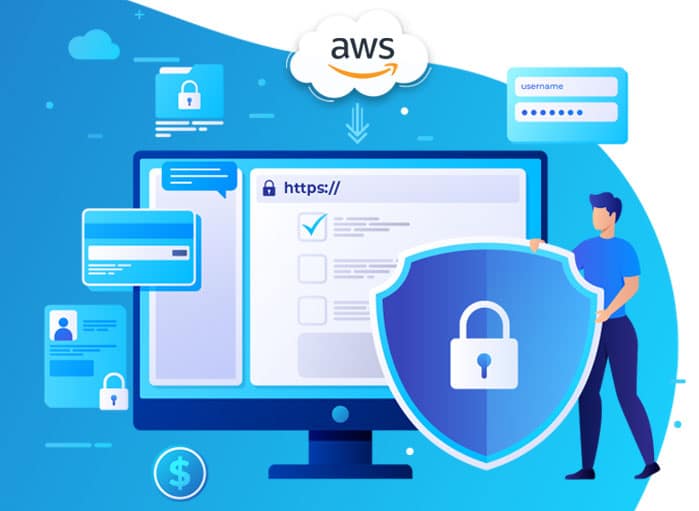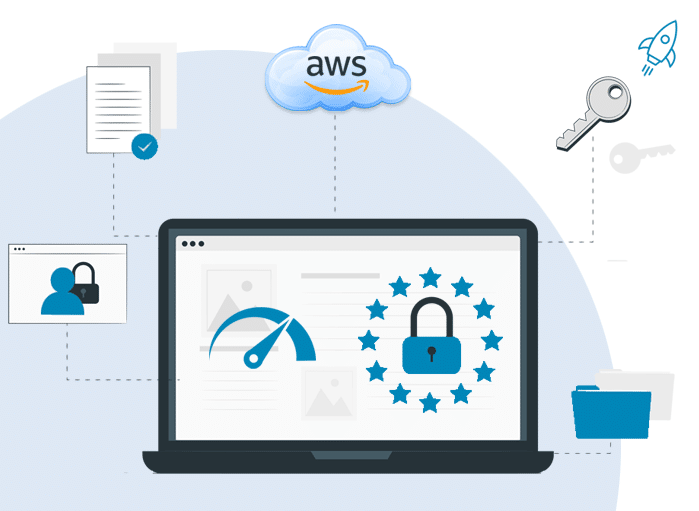
AWS for Higher Education: Harnessing the Power of Cloud
Tags: AWS,Higher Education


In today’s digital age, higher education institutions are turning to cutting-edge technology to enhance the learning experience of students, streamline administrative processes, and drive research innovation. One such technology that has proven to be a real game-changer in the world of higher education is AWS for higher education.
Well, there is no denying that the Amazon Web Services (AWS) hosting is a powerful cloud computing platform that offers a wealth of opportunities for students to researchers, and even to higher education institutions. With AWS higher ed platform, it’s easy to embrace the future of learning.
1. Ushering a New Era of Education with AWS

As the world of higher education embraces the digital revolution, institutions are looking out for innovative ways to enhance the learning experience of students and streamline the entire operations.
Enter AWS Hosting – a cutting-edge cloud computing platform that’s transforming the higher education landscape.
Let’s dive into the world of AWS and then see how AWS for higher education can empower colleges and even universities in the digital age. In short, let’s see how it’s revolutionizing higher education.
2. AWS: A Cloud Computing Powerhouse
Amazon Web Services (AWS) is a leading cloud computing platform offering a wide range of services, starting from computing and storage to databases and analytics tools.
In fact, the platform’s flexibility, reliability, and cost-effectiveness make it a great option for business organizations and educational institutions that look forward to modernizing their digital infrastructure and stay ahead of the curve.
As a matter of fact, AWS Cloud services like AWS for higher education enable higher educational institutions to access resources on-demand, scale their infrastructure as needed, and pay only for the services they use from time and again.
Now that you have a good idea about AWS hosting solutions, let’s see how AWS higher ed is going to empower colleges and universities.
3. Way in Which AWS for Higher Education is going to Help Higher Education
As the digital age continues to reshape the world of higher education, AWS for higher education emerges as a powerful catalyst for transformation. In other words, AWS through its cutting-edge cloud computing solutions, is empowering colleges and universities to enhance the learning experiences of students while driving innovation.
In fact, AWS higher ed is designed in a way to help institutions navigate the challenges of the digital era and unlock the full potential of cloud hosting technology in education.
3.1. Scalability Meeting Flexibility
It’s true that higher education institutions often face distinct types of demands during the peak registration period or during any online events when the site experiences high traffic.
However, with the help of AWS cloud hosting’s scalable and flexible infrastructure allows colleges and universities to easily adapt to these changes. This, in turn, ensures a seamless user experience and optimized performance.
3.2. Security That One Can Trust
Whether it’s an educational website or a government website, it’s crucial to protect sensitive data. By saying protecting sensitive data, we mean to show data, such as student records and any research information.
Protecting all these types of data should be a top priority for higher education institutions. AWS for higher education comes with robust security features, like encryption, multi-factor authentication, and monitoring tools, which easily safeguard digital assets. Plus, it can maintain necessary compliance with industry standards.
3.3. Cost-Effective and Efficient Solutions
Cloud hosting platforms, such as AWS higher education is known to have a Pay-as-You-Go pricing model. This pay-as-you-go model allows institutions to easily minimize the upfront costs and only pay for the services they are using.
So, this cost-effective approach from AWS higher ed is going to allow colleges and universities to allocate more resources in places that will enhance the student experience and supporting the research initiatives of the students.
3.4. Unleashing Improved Collaboration

Gone are the days of working in silos! AWS for higher education fosters seamless collaboration between faculty, staff, and students through its cloud-based tools and platforms. In other words, AWS cloud is not only limited to students but its available for teachers and faculty alike.
Enhanced connectivity that one gets to see through the AWS cloud not only eases cross-disciplinary research, but also supports remote learning. Plus, it even improves overall communication within the institution.
3.5. Accelerating the Research Process
There is no denying that research forms the heart of higher education, and AWS is playing a significant role in accelerating the research process. Researchers can harness the power of AWS’s high-performance computing resources and advanced analytics tools for accelerating their research.
Also, it helps the researchers to analyze large datasets to run complex simulations. Plus, AWS cloud hosting solution empowers researchers to collaborate on ground-breaking projects and drive innovation.
3.6. Streamlined Administrative Process
AWS’s extensive suite of services can help higher education institutions streamline their administrative processes, from managing student records to handling financial transactions.
By automating and centralizing these tasks through AWS, institutions can improve efficiency, reduce human error, and focus on providing a superior educational experience.
There is nothing wrong with saying that AWS like AWS for higher education is revolutionizing higher education by offering scalable, secure, and cost-effective solutions is enhancing the learning experience and streamlining operations.
Now let’s explore AWS cloud hosting services for higher education and how it will benefit educational institutions.
4. AWS Cloud Hosting Services for Education
In the remaining blog post, let’s take you through the various AWS services that can be used by colleges and universities. Also, explore the benefits that educational institutions will get to enjoy if they avail any one of the following AWS services including Elastic Compute Cloud (EC2), Simple Storage Service (S3), Relational Database Service (RDS), and so on.
5. AWS for Higher Education: Types of Hosting Services Available
These are some popular hosting service types available under AWS for higher education. We need to know about them.
5.1. Elastic Compute Cloud (EC2)
Elastic Compute Cloud (EC2) is one of Amazon Web Services’ (AWS) flagship offerings. This service is truly a game-changer for higher education institutions seeking to revolutionize their IT (Information Technology) infrastructure.
5.1.1. Leveraging EC2 for Higher Education
AWS higher ed services like EC2 provide scalable, on-demand computing resources, enabling institutions to meet their ever-changing needs. Let’s explore some benefits and use cases of EC2 in higher education.
5.1.2 Benefits of EC2 for Higher Education
The benefits of using Elastic Compute Cloud for higher education
5.1.2.1. Scalability
With EC2, higher education institutions can easily scale their computing resources up or down based on demand. This flexibility is crucial for handling varying workloads, such as during peak registration times or high-demand research projects.
5.1.2.2. Cost Savings
EC2’s pay-as-you-go pricing model allows institutions to optimize costs by only paying for the resources they need, rather than investing in expensive on-premises hardware, going for services like EC2 is ideal for AWS for higher education.
5.1.2.3. Security
EC2 ensures top-notch security for sensitive data with built-in firewalls, encryption, and compliance standards, giving institutions peace of mind.
5.1.2.4. Reliability
EC2’s highly available infrastructure ensures minimal downtime, enabling institutions to provide uninterrupted services to their students, faculty, and staff.
5.1.3. Use Cases for EC2 in Higher Education
Before availing of EC2 as a part of AWS for higher education, having some knowledge of its use cases is important. It can be used for research work to web hosting needs and more.
5.1.3.1. Virtual Learning Environments
EC2 enables institutions to host virtual learning environments, such as Learning Management Systems (LMS), where students and faculty can access course materials, submit assignments, and take part in discussions.
5.1.3.2. Research Computing
EC2 provides the high-performance computing resources needed for complex research simulations, data analysis, and modeling, empowering researchers to make groundbreaking discoveries.
5.1.3.3. Web Hosting
Institutions can use EC2 to host their websites and web applications, ensuring fast loading times and a seamless user experience for students, faculty, and visitors.
5.1.3.4. Big Data Analytics
With EC2, higher education institutions can process and analyze vast amounts of data to make data-driven decisions. This in turn enhances the student experience and improves institutional effectiveness.
In short, AWS for higher education services like Amazon EC2 offers an array of benefits and use cases for higher education institutions looking to modernize their IT infrastructure.
By leveraging EC2’s scalability, cost savings, security, and reliability, institutions can support their academic and research endeavors while providing a top-notch experience for students and faculty.
5.2. Simple Storage Service (S3)
Another AWS higher service for students to educational institutions is AWS S3. Well, Amazon Simple Storage Service (S3) is a powerful and versatile storage solution that’s quickly becoming indispensable for higher education institutions.
5.2.1 Harnessing S3 for Higher Education
S3 offers a range of storage classes to meet different use cases, including S3 Standard, S3 Intelligent-Tiering, S3 Glacier, and S3 Glacier Deep Archive.
S3 provides scalable, durable, and cost-effective storage, making it an ideal choice for managing data in the ever-evolving world of higher education. Let’s dive into the benefits and use cases of S3 in higher education.
5.2.2 Benefits of S3 for Higher Education

Higher educational institutions opting for storage services like S3 as a part of AWS for higher ed get to enjoy the following benefits.
5.2.2.1. Scalability
S3’s virtually unlimited storage capacity allows institutions to scale their storage needs effortlessly, accommodating the growing volume of data generated by students, faculty, and research projects.
5.2.2.2. Cost Efficiency
S3’s pay-as-you-go pricing model enables institutions to optimize their expenses by only paying for the storage they use, rather than investing in costly on-premises infrastructure.
5.2.2.3. Data Durability & Security
S3 ensures high data durability with built-in redundancies and multiple layers of security, including encryption, access control policies, and compliance certifications, safeguarding sensitive information.
5.2.2.4. Ease of Use
S3’s intuitive web interface and compatibility with various programming languages and frameworks make it a user-friendly storage solution for higher education institutions.
5.2.3. Use Cases for S3 in Higher Education
Now let’s take you through some use cases of S3 storage service that can be availed by colleges and institutions.
5.2.3.1. Course Content Storage
Institutions can use S3 to store and distribute course materials, such as lecture recordings, presentations, and reading materials, providing students and faculty with easy access to resources.
5.2.3.2. Research Data Storage
S3 provides a secure and scalable storage solution for research data, including large datasets, images, and videos, facilitating collaboration among researchers and safeguarding intellectual property.
5.2.3.3. Backup & Archiving
Institutions can leverage S3 for data backup and archiving purposes, ensuring data preservation and compliance with regulatory requirements.
5.2.3.4. Web & Application Hosting
Higher education institutions can use S3 to host static websites, multimedia content, and application data, ensuring fast loading times and a seamless user experience.
By using AWS for higher education services like S3’s scalability, cost efficiency, security, and ease of use, institutions can better support their academic and research missions while enriching the experience of students and faculty.
5.3. Relational Database Service (RDS)
Amazon Relational Database Service (RDS) is a fully managed, reliable, and efficient database service, that provides an invaluable resource for higher education institutions.
5.3.1. Empowering Higher Education with RDS
RDS is easy to set up, operate, and scale a relational database in the cloud. With RDS, you can choose from six popular database engines, including MySQL, PostgreSQL, and SQL Server.
RDS simplifies the process of setting up, operating, and scaling relational databases, enabling institutions to focus on their core academic and research goals. Let’s explore the benefits and use cases of RDS in higher education.
5.3.2. Benefits of RDS for Higher Education
Wondering how RDS, which is a part of AWS for higher education, can help? You must read on.
5.3.2.1 Time & Resource Savings
RDS automates time-consuming administrative tasks such as hardware provisioning, database setup, patching, and backups, allowing institutions to devote more resources to their primary objectives.
5.3.2.2 Scalability
RDS allows institutions to scale their database resources seamlessly, adapting to the changing needs of students, faculty, and research projects.
5.3.2.3 Cost Efficiency
With RDS’s pay-as-you-go pricing model, institutions can optimize their expenses by only paying for the resources they use, instead of investing in expensive on-premises infrastructure.
5.3.2.4 High Availability & Durability
RDS ensures high availability and durability through automated backups, multi-AZ deployments, and built-in disaster recovery features, providing uninterrupted access to critical data.
5.3.3. Use Cases for RDS in Higher Education
Now let’s take you through some use cases of RDS service which is a part of AWS for higher ed. They are:
5.3.3.1. Student Information Systems
RDS can be used to manage student information systems, storing and organizing data on student enrollment, course registrations, grades, and more.
5.3.3.2. Research Data Management
Institutions can leverage RDS for managing and analyzing research data, enabling researchers to derive insights and make data-driven decisions.
5.3.3.3. Learning Management Systems
RDS provides the backbone for Learning Management Systems (LMS), storing course content, student progress, and assessment data, ensuring a seamless learning experience for students and faculty.
5.3.3.4. Alumni & Donor Management
Higher education institutions can use RDS to manage alumni and donor databases, facilitating communication, engagement, and fundraising efforts.
Well, by harnessing RDS’s time and resource savings, scalability, cost efficiency, and high availability, institutions can better support their academic, research, and administrative endeavors, ultimately enhancing the experience for students, faculty, and staff.
Now that we know of the services under AWS for higher education, it’s time to learn about the AWS hosting best practices for education.
6. AWS for higher education: Hosting Best Practices
As higher education institutions increasingly adopt cloud-based solutions like AWS, adhering to best practices are crucial for ensuring a smooth transition and maximizing the advantages of this robust platform. In this engaging blog, we’ll delve into AWS hosting best practices designed specifically for higher education, supported by real facts and figures to emphasize their impact.
6.1. Adopt a Well-Architected Framework
A well-architected framework is essential for attaining security, reliability, performance efficiency, cost optimization, and operational excellence on AWS.
As shown in an AWS case study, the University of Notre Dame was able to reduce its data center footprint by 50% and save over $1.5 million by embracing a well-architected framework on AWS.
6.2. Choose Multi-Factor Authentication (MFA)
Implementing multi-factor authentication (MFA) is vital for safeguarding sensitive data and resources. MFA adds an additional layer of security, minimizing the risk of unauthorized access.
For example, the California State University system utilizes AWS MFA to fortify its cloud infrastructure’s security.
6.3. Utilize AWS Educate
AWS Educate is an international initiative that offers cloud-related learning resources to students and educators. By leveraging AWS Educate, Institutions like Northern Virginia Community College successfully trained over 500 educators and equipped more than 10,000 students with sought-after cloud skills.
6.4. Investigate Cost-Saving Options
AWS provides various cost-saving opportunities, such as Reserved Instances, Savings Plans, and Spot Instances, which can substantially lower hosting expenses. The University of Arizona reportedly saved 60% on its AWS costs by adopting these strategies.
6.5 Focus on Data Privacy and Compliance
Ensure your institution’s AWS infrastructure adheres to relevant data privacy regulations like FERPA, HIPAA, and GDPR. AWS offers numerous tools and services to assist with maintaining compliance, including AWS Artifact, AWS Config, and Amazon Macie.
6.6. Employ a Hybrid Cloud Approach
A hybrid cloud approach blends on-premises infrastructure with AWS services, granting flexibility and control over data and applications. The University of California San Diego employed a hybrid cloud strategy to optimize its high-performance computing workloads, achieving 50% cost savings and a 15x performance boost.
In short, embracing AWS high ed can considerably improve how higher education institutions utilize cloud services. By concentrating on a well-architected framework, security, cost-saving measures, and compliance, institutions can unleash AWS’s full potential and pave the way for a brighter future for their students and faculty.
7. Success Stories of AWS from UC San Diego and Arizona State University
As higher education institutions embrace cloud-based solutions like AWS, it’s essential to understand the real-world impact of these technologies.
Here we’ll explore two compelling case studies showcasing how AWS hosting has transformed higher education at the University of California, San Diego (UCSD) and Arizona State University (ASU).
7.1 Instance 1: University of California, San Diego
The University of California, San Diego (UC San Diego or UCSD) is a renowned public research university located in the picturesque coastal region of La Jolla, California. Established in 1960, UCSD is a member of the prestigious University of California system and has rapidly ascended to become a leading institution in higher education, research, and innovation.
7.1.1. Optimizing High-Performance Computing with a Hybrid Cloud Strategy
UCSD faced the challenge of optimizing its high-performance computing workloads while managing its on-premises infrastructure. To address this issue, the university turned to AWS and implemented a hybrid cloud strategy.
By leveraging AWS services like Amazon EC2, S3, and RDS, UCSD could seamlessly integrate their on-premises infrastructure with the cloud. This approach provided flexibility and control over data and applications, resulting in significant benefits:
7.1.1.1 50% cost savings
By utilizing AWS services, UCSD reduced its overall infrastructure costs by half.
7.1.1.2. 15x performance improvement
The university experienced a 15-fold increase in computing performance, enabling faster and more efficient research.
7.2 Instance 2: Arizona State University
Arizona State University (ASU) is a highly respected public research institution located in the metropolitan area of Phoenix, Arizona. Founded in 1885, ASU has grown into one of the largest universities in the United States, with a commitment to innovation, inclusion, and accessibility.
7.2.1. Innovating Online Learning with AWS
Arizona State University recognized for its innovative approach to online learning, sought to enhance the student experience by leveraging AWS hosting. ASU utilized a range of AWS for higher education services, including Amazon S3, Lambda, and Elastic Beanstalk, to build and deploy their cutting-edge digital learning platform.
The AWS-powered platform provided ASU with many advantages:
7.2.1.1 Scalability
ASU could effortlessly scale their infrastructure to accommodate a rapidly growing online student population.
7.2.1.2. Enhanced student experience
With AWS, ASU created a personalized, responsive, and interactive learning environment for their online students.
7.2.1.3. Cost efficiency
By optimizing their use of AWS services, ASU achieved significant cost savings in hosting and infrastructure management.
The instances of using AWS higher education services by UC San Diego and Arizona State University illustrate the transformative potential of AWS hosting in higher education.
By using AWS services, these institutions have optimized their infrastructure, enhanced student experiences, and achieved cost savings. As cloud-based solutions like AWS continue to evolve, higher education institutions will undoubtedly benefit from embracing these innovative technologies.
8. AWS as an Innovation Partner

What sets AWS for higher education apart from other cloud computing platforms? Well, the answer to this question lies in its commitment to being a partner in innovation for higher education institutions.
With a wealth of resources, such as webinars, tutorials, and industry insights, AWS empowers institutions to stay ahead of the curve and explore new ways of leveraging technology to enhance the educational experience.
9. What do Reports say?
According to the Innovation Drivers in Higher Education report, the future roadmap for AWS is on teaching, research, and even learning.
Basically, the report, “Innovation Drivers in Higher Education,” examines the emerging priorities affecting institutions, highlighting three primary themes fueling higher education’s digital transformation:
- Institutions are innovating to address learner requirements and revamp the student experience.
- Cybersecurity’s significance grows as policies change and threats to sensitive research and student data escalate.
- Institutional leadership’s focus on sustainability intensifies due to rising energy costs, climate change, and increased student demand for action.
In simple words, this report holds insights from global higher education leaders, including The University of British Columbia, The University of Pennsylvania, Hamdan Bin Mohammed Smart University, and the Queensland University of Technology. Amazon Web Services (AWS) subject matter experts also contribute their valuable knowledge.
10. How Is It Going to Help?
To understand AWS higher ed in a better way from the report, let’s dive in.
10.1 Expanding Choices & Focusing on Students in Teaching and Learning
Teaching is undergoing a transformation to align with students who want to learn, either in-person or online or through hybrid flexibility model.
The digital solutions that various EdTech companies are offering are going to help primary to secondary, and even post-secondary institutions to respond with tools that will eventually help to improve the learning outcomes. At the same time, it will bridge the gap between traditional instructional design models and student preferences.
In short, there is a move towards personalized, as well as lifelong learning while using artificial intelligence (AI), machine learning (ML), and data analytics for student performance assessment and many more things.
10.2 Scalable Security: A Crucial Need in the Research Community
With the rise of computational research and online collaborations, safeguarding research data has become a top priority for institutions and governments. Establishing scalable systems and controls to protect intellectual property is essential for the research community’s success.
10.3 Institutional Leadership Embraces Sustainability with Renewed Focus
Sustainability has become a top priority for higher education institutions globally. It’s now integrated into strategies, funding, curricula, governance, and community engagement. Institutions are appointing senior-level sustainability-focused roles, directing funds to sustainability initiatives, and using cloud-based data to make more sustainable decisions.
Educational institutions are so inspired by the power of AWS that they are partnering with AWS providers to leverage the full potential of AWS for higher education and accomplish educational objectives.
11. Colleges & Universities Are Benefitting from Cloud Strategy
Since the pandemic, it was clear that higher education faced a lot of challenges. In fact, a sharp decline in student enrolment that began in the United States before the pandemic just got worsened post-pandemic.
According to the National Student Clearinghouse Research Center, enrollment fell by 3.2% from 2020 to 2021.
In another instance, according to the Institute for Fiscal Studies, in 2020, 13 universities were facing the risk of bankruptcy in the UK (United Kingdom).
Despite all these hurdles and pressures, higher education institutions are trying hard to offer education access to a large group and diverse population. Leaders are rethinking ways to support students on their academic journeys, personalizing learning experiences, providing flexible modalities, and enhancing student well-being, including mental health.
In a nutshell, higher education must adapt swiftly to ever-changing circumstances. The 2021 Inside Higher Ed survey revealed that 78% of college and university presidents see the pandemic as a catalyst for transformation, while 34% view it as a chance to “reset for growth.”
Furthermore, 52% acknowledge the need for faster decision-making in governance structures. Essentially, institutions that rapidly embrace and adapt to technology integration will be at the forefront of shaping the future.
11.1 The Transformation That Is Taking Place
At the heart of this transformation lies data. It has the potential to enhance student retention, promote diversity, support online and hybrid learning, manage facilities sustainably, personalize learning experiences, achieve operational efficiency, and improve student outcomes.
However, institutions often struggle to utilize data effectively, as it’s locked away in siloed databases, such as student information systems (SIS), learning management systems (LMS), and other operational or compliance-oriented databases. These databases are great for operational processing but fall short for open-ended analysis.
Data-informed educational institutions harness the power of data to improve mission outcomes. They do so by utilizing data in decision-making processes and making it accessible to foster innovation and enhance student outcomes. In essence, embracing data-driven strategies is key to unlocking the full potential of higher education institutions in today’s fast-paced world.
11.1.1. Use Cases of AWS for Higher Education
To help you better understand how harnessing data is helping to transform education, let’s take you through one example.
A prime example of the power of data in education comes from a leading Australian university. They discovered that 16% of their student population was at risk of dropping out.
By designing targeted intervention programs, they expected a 14% improvement in student satisfaction and a prevention of revenue losses up to $189 million.
11.1.1.1. Innovative EdTech Solutions
Alef Education, an EdTech provider in the UAE, takes data usage to the next level. They collect 100 million data points daily through their learning platform. This data helps create a real-time dashboard on student progress, triggering automated processes like targeted support, assessments, and grading.
11.1.1.2. Combating Dropout Rates with Data
Betha Sistemas, a Brazilian technology company, collaborates with education secretaries in Brazil to reduce dropout rates. Their predictive model, based on 17 variables from student profiles, successfully reduced attrition by 20% in the city of Bombinhas.
11.1.1.3. Adapting to a Changing World
To fully use data in a rapidly changing world, educational institutions must prioritize agility and flexibility in their data handling. This includes the tools used for analysis, the questions posed to their data, and the ways they operationalize learnings from the data. In turn, this data-driven approach enables institutions to become nimbler and face emerging challenges head-on.
11.1.1.4. Maximizing Data Availability
Institutions need to ensure maximum data availability while respecting privacy and confidentiality guidelines.
Providing faculty and staff with tools to explore data in unexpected ways and harness the latest advances in analytics, such as machine learning, is essential. Equally important is cultivating the ability to interpret data rigorously and creatively.
12. AWS Hosting in Higher Education: Paving the Way for a Brighter Future
Higher education institutions are rapidly adapting to the digital revolution, requiring powerful tools to stay ahead in the ever-evolving landscape. Amazon Web Services (AWS) has become a trusted and efficient hosting solution for universities and colleges looking to enhance their digital infrastructure. In this blog, we will discuss emerging trends in higher education and the vital role AWS hosting will play in shaping the future of education.
12.1 Emerging Trends in Higher Education
What are the emerging trends in higher education and how AWS is going to help? If you have this question in mind, read on.
12.1.1. Digital Transformation
One of the most significant trends in higher education is the ongoing digital transformation of campuses. Universities are investing heavily in technologies such as artificial intelligence (AI), machine learning (ML), and the Internet of Things (IoT) to keep pace with the changing world.
AWS hosting enables institutions to seamlessly integrate these technologies into their operations, facilitating data-driven decision-making.
12.1.2. Online Learning
The growing popularity of online learning is another major trend in higher education. Distance education programs have gained traction in recent years, thanks to technological advancements.
AWS hosting allows universities to develop robust online learning platforms that deliver top-notch learning experiences to students, regardless of their location.
12.2. The Role of AWS Hosting in Higher Education

It is vital to understand the role of AWS hosting services when educational institutions are opting for AWS for higher education. Only then will they understand how it is going to benefit them.
12.2.1. Cost-Effective
One of the biggest advantages of AWS hosting for higher education is its cost-effectiveness. With AWS, universities can easily scale their infrastructure up or down, depending on their needs, without worrying about the costs associated with maintaining physical servers. AWS also offers pricing models that are flexible and budget friendly.
12.2.2. Scalability
AWS for higher education through hosting services also provides the scalability needed to handle the increasing demands of digital transformation and online learning.
As more students and faculty members use online resources and applications, the need for scalable hosting solutions becomes more important.
AWS can handle these demands with ease, ensuring that universities can focus on delivering high-quality education to their students.
12.2.3. Reliability
AWS is known for its reliability, which is crucial for higher education institutions that need to provide uninterrupted access to their resources. With AWS hosting, universities can ensure that their online learning platforms and digital infrastructure are available 24/7, without any downtime or interruptions.
The future of higher education is digital, and AWS hosting will play a significant role in shaping that future. As universities continue to adopt new technologies and expand their online learning programs, AWS provides a cost-effective, scalable, and reliable hosting solution that can meet their needs.
By leveraging AWS, universities can focus on what matters most – providing a high-quality education to their students.
13. Professional Help
Do you need help with AWS hosting services? You can get the help of eWay Corp professionals for this. As AWS Partners, eWay Corp can help educational institutions to have a better understanding of the platform.
14. Final Thoughts
To sum it all up, AWS is revolutionizing higher education by offering scalable, secure, and cost-effective solutions that address the unique challenges institutions face in the digital era. By embracing the power of AWS for higher education, colleges, and universities can propel their institutions into the future of learning.



